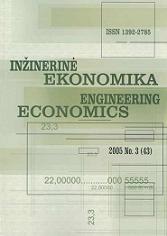Distribution of Costs of Tertiary Education Between Direct Beneficiaries and Society
Distribution of Costs of Tertiary Education Between Direct Beneficiaries and Society
Author(s): Zita Tamašauskienė, Dalia RudytėSubject(s): Economy
Published by: Kauno Technologijos Universitetas
Keywords: private and public benefits of tertiary education; financing of tertiary education; private and public costs of tertiary education; distribution of costs of tertiary education between beneficiaries; loans for studies.
Summary/Abstract: Development of modern knowledge economics en-hances importance of education policy. Nowadays, terti-ary education systems of developed countries become more and more massed. Such development of tertiary education is necessary and desirable. However, most of countries, including those with very high economies, face the problems of financing for tertiary education, possi-bilities to guarantee additional financing, cost distribu-tion between direct beneficiaries of tertiary education and society. In Lithuania, during the last ten years, number of students increased more than three times, however the means, assigned for tertiary education, increased much slower. Therefore, financing per student is 2.4 times lower than in 25 EU member states according to the standards of purchasing power. The governments of all countries subsidize tertiary education. Traditional argument for public financing of tertiary education is positive external benefit and stimu-lation of economic growth. The subsidies to tertiary edu-cation stimulate investment into human capital; otherwise they would be ineffectively low due to positive external benefit. Other arguments for national financing of terti-ary education are related with imperfect markets of loans for studies, risks of investment into tertiary education, absence of possibilities to insure risks of studies. Tertiary education provides not only public, but also private benefit, demonstrated by much higher wages of graduates in comparison with the ones of employees, who have graduated from secondary schools. Calculations made by the author of the present article demonstrate that private rate of return to tertiary education in Lithua-nia is sufficiently high, it is higher than rates of return from other assets and it reaches 12.87%. Other private benefit is related with lower risks of unemployment, longer participation in labour market.
Journal: Engineering Economics
- Issue Year: 2007
- Issue No: 3 (53)
- Page Range: 17-24
- Page Count: 8
- Language: English

